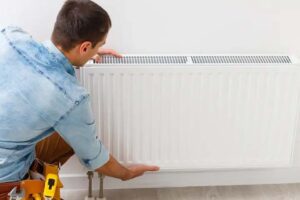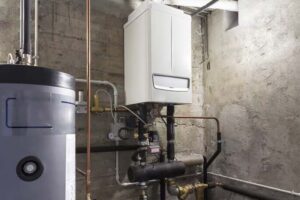Table of Contents
The diverter valves are an important part of a property’s boiler system, responsible for directing water to either the radiators or taps in your home. When this valve gets stuck, it can lead to issues like lukewarm water or heating problems. This article is for you who want to get an overall knowledge of how to free a stuck diverter valve.
What is a Diverter Valve?
A diverter valve is a mechanism inside your boiler used to control the flow of water, directing it to either the central heating system or the hot water taps.
Through the diverter valve, a boiler will examine the flow of hot water depending upon which fixture is being used. When the valve gets stuck, it can disrupt this flow, leading to heating and hot water issues.
How does a diverter valve work?
System and conventional boilers don’t need diverter valves, since they save the hot water in a tank. You can only find it on a combi boiler because they heat the water on demand directly when the tap is on. A boiler’s diverter valve has the same function as the one on a showerhead – it examines the flow of hot water to different pathways.
When it comes to a home heating system, the diverter valve boiler will open in order to let the heat reach the radiators. Once there is a demand for hot water in the tap or showerhead (usually when you turn on the hot water), the valve will close. If you are not using the taps or showerheads, the diverter valve boiler would stay open to keep the radiators warm.
Signs of a Stuck Diverter Valve
Taps are not getting hot water
The most common sign of a faulty diverter valve stuck is when you don’t get any hot water to your taps and showerheads. The water gets heat at best, but no more. This means that the boiler isn’t working properly. The hot water to the fixture is in use because the diverter valve is stuck open, and the heat is escaping.
Lots of hot water, but no heating
When you turn on the heating system during the winter months, your radiators should be warm, and hot water should be reaching the taps. Although, if you have hot water in the taps and showerheads, but no room heating, then you have the opposite of the last issue – the diverter valves are stuck closed and are not letting the heat reach the radiators. If your heaters are only cold at the bottom, though, there’s a separate issue.
You have hot water only if the heating is on
If you are not using your heating system in summer, you should still be able to have hot water reaching the taps, showerhead. If you don’t have hot water when the heating is off but you do when the heating is turned on, then once again, you find you have a faulty diverter valve.
Steps to Free a Stuck Diverter Valve
Identify the Issue
Run your taps on hot and observe the diverter valve. If it fails to move or close when hot water is run, it is likely stuck.
Avoid DIY Fixes
It is not recommended to attempt fixing the stuck diverter valves yourself. Instead, seek the assistance of a qualified professional to avoid causing further damage.
Professional Assistance
Contact a reputable boiler service provider or engineer to inspect and address the stuck diverter valve. They have the expertise and tools to resolve the issue safely and effectively.
Preventive Maintenance
Regular boiler servicing can help prevent diverter valve issues. A professional service can identify potential problems early on and ensure the smooth operation of your boiler system.
Need a Professional
While it may be tempting to try DIY solutions or use products like WD40 to free a stuck diverter valve, it is crucial to prioritise safety and effectiveness. Professional assistance ensures that the problem is diagnosed accurately and resolved without causing further damage to your boiler system.
Cost of Fixing a Stuck Diverter Valve
As discussed, you must hire a qualified heating engineer to have a stuck diverter valve fixed.
But how much would this actually cost? Let’s take a look…
The average cost of resolving a stuck diverter valve:
| Services | Cost |
| Cleaning and refitting a stuck diverter valve | £40 to £130 |
| Replacing the diverter valve | £80 to £200 |
| Replacing an entire boiler | £3000 to £4,000 with installation cost* |
Thankfully, though, there are alternatives to obtaining a boiler other than simply paying the full cost upfront. If you are out of budget, then you don’t need to worry about that. We have a stress-free solution; we’ll provide you warmth through the UK government’s initiative, the ECO4 scheme. In this scheme, the government provides boiler replacement grants to eligible homeowners living in the UK. There are different perspectives on eligibility check Grant Boilers to see whether you’re eligible or not.
Conclusion
A stuck diverter valves can disrupt the functionality of your boiler system, leading to heating and hot water issues. By understanding the signs of a stuck diverter valve, seeking professional assistance, and prioritising preventive maintenance, you can ensure the efficient operation of your boiler and avoid potential problems in the future. Remember, when it comes to a stuck diverter valve, it’s best to leave the task to qualified professionals for a safe and reliable solution.




